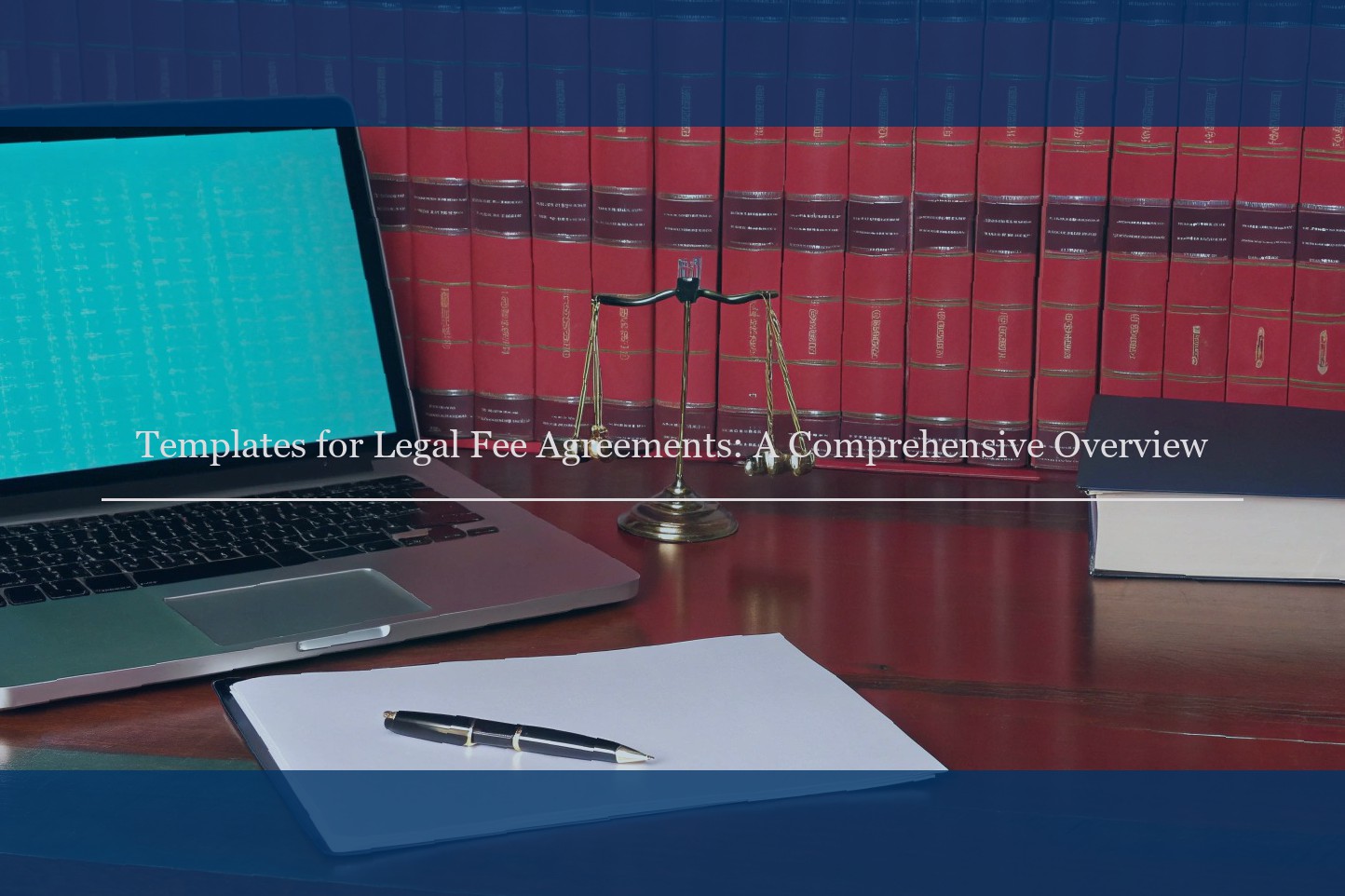Templates for Legal Fee Agreements: A Comprehensive Overview
What Constitutes a Legal Fee Agreement?
A legal fee agreement is a written contract entered into between the attorney and the client that details the terms under which legal services will be provided. In general, it lists the responsibilities that both parties must agree to – for instance, the attorney should provide competent representation and the client should be honest and cooperate with the attorney. It should specify exactly what services are included, estimate the fees that will be charged and how (by the hour or billed flat), disclose any other costs involved and explain when payment is required . This agreement should also indicate what happens if the attorney terminates the relationship or if the client complains about insufficient legal service. The legal fee agreement is very important in that it sets the foundation of the legal relationship. It can help to prevent any misunderstandings later on after the relationship has been formed. It also minimizes the risk that the attorney will be unable to recover fees on any legal services rendered to the client, provided that the client does not accept any behavior that is negligent or represents a breach of ethics in the attorney.
Essential Elements of a Legal Fee Agreement Template
A well-prepared legal fee agreement template should include certain essential components to set the right expectations and limits. The following are some of the crucial elements every agreement should have.
Fee Agreements: Retainers, Hourly Fees and Contingent Fees are the primary legal fee structures. A retainer agreement sets forth a fixed fee charge for a specified scope of services (like a legal audit or incorporation services) or a non-refundable retention of a specific amount to be used for a certain period of time. An hourly fee agreement contains a specified hourly rate charged in 10 minute increments. A contingent fee agreement is where an attorney agrees to accept payment for services only if certain conditions are met (like a successful recoverable claim or financial award).
Scope of Services: The legal fee agreement template should clearly specify what the law firm will do for the client, e.g. to prepare a will or to consult in a real estate closing transaction. It should also specify what not to expect, e.g. the attorney will not provide psychological counseling to the client.
Client Responsibilities: The legal fee agreement template should clearly specify the responsibilities of the client including a warning that entry of an order does not guarantee or insure the result and that the client must be available to call as the process progresses. It should also make it clear that the client is responsible for using his or her best efforts to overcome any obstacles in the process (e.g. obtaining prior approvals and responding to issues that arise).
Fee Structures Available in Legal Fee Agreements
The most common fee agreement a lawyer utilizes is for hourly billing. With an hourly agreement, a lawyer is paid for the amount of time they spend on your case. Hourly fees can be less risky for the lawyer and more unpredictable for clients, and demand for high quality lawyers can ultimately lead to high hourly rates.
Flat fees from a client are a way for a lawyer to guarantee a certain amount of income for a case. In these arrangements, the client pays the lawyer a set fee in advance, often with a guarantee of the services rendered. Most fee agreements include a clause stating that the flat fee may change if the requirements of a case change.
Contingency fee agreement templates can help lawyers get cozy with break fees, but to the client, fees based on how likely it is to win a case can put a level of pressure on a lawyer to win that isn’t helpful to anyone.
Retainer fee agreements are probably the most complex and least common types of fee agreements. A retainer is a downpayment of legal fees typically used to secure a lawyer’s services and payment is deducted from the retainer as time is billed. Retainers are not as common as they once were, which has been a source of debate as many lawyers would prefer full upfront payment or payment on a contingency basis.
How to Personalize Your Legal Fee Agreement Template
Parties may modify a standard template to fit the specific circumstances of a given case, transaction, or matter. These modifications may include, but are not limited to, the following:
By discussing these issues and others related to your particular case, you can further shape the language of the legal retainer agreement template to ensure that you sufficiently address your needs. Like any contract, this is an area of law that is very fact-specific and subject to negotiation.
Common Pitfalls
When reviewing these fee agreements, I’ve seen many mistakes clients and attorneys make. Here are some of the most common:
- Be wary of any attorney who does not use a written fee agreement. Even though it is not required by the Pennsylvania Rules of Professional Conduct, attorneys need to have a written fee agreement prepared to confirm their engagement with you.
- Pay very attention to any "Installment Payment" requirement at the outset of your engagement. This confirms that you understand and agree to the payment plan as it is designed, so be careful not to overlook this.
- Pay close attention to how monthly billing will be handled. Many larger law firms (with multiple attorneys working on one matter) include this in their engagement agreements. They will bill for your matter on a fixed date every month . If your matter wraps ups before the end of the month or is delayed beyond the date of your next monthly billing date, you will typically receive a prorated bill.
- The billings are not coincident with your monthly retainer and retainer balance is prepared. This means your attorneys are simply billing you for their time and expenses (less the retainer).
- Look for minimum billing times of one-tenth or one quarter of an hour for any action. One-tenth of an hour is 6 minutes, and one quarter of an hour is 15 minutes. Very few attorneys will charge you for less time than that.
- Be VERY careful with the use of the term "substantial involvement" when discussing or reviewing your fee agreements. This generally means that the attorney you consult with when you sign the agreement will not be the attorney who handles your matter. So, make sure you understand who is or will be working on your matter and if that person is the best choice for you.
Legal and Ethical Issues
Both state law and the rules of bar associations regulate the use of legal fee agreements. Most states, including California, require clients to be given copies of the fee agreements and to be provided with a reasonable opportunity to review the agreements. Also, clients must be provided with copies of the client trust account rules and information on how to contact the state bar association if the client has a complaint. Bar associations also outline certain required disclosures when entering into hourly agreements and flat legal fee agreements must comply with the state law disclosure requirements. In general, flat fee agreements, billing for attorneys’ fees on an hourly basis and retainers are legal in every state. Many states have a state-mandated hourly fee, and some state bars have set minimum hourly billing requirements. If you wish to charge less, your state bar association will provide the applicable regulations.
At the recent 2019 California Solo Summit, Alison Sanchez-Mason, a partner at Bay Area law firm Wendel, Rosen, Cellini, Steinhart & Goodman LLP, provided an insightful legal ethics class about the risks lawyers face if they don’t document their client agreements properly. "Rule 4-200" of California’s Rules of Professional Conduct requires lawyers to charge a "reasonable" fee that is not "unconscionable" or "illegal." While a California State Bar court opinion does not define what languages "unconscionable" or "illegal" mean, California courts do have guidelines that help to define the terms. For example, California State Bar Court Opinion No. 98-C-13605 (a disbarment case) stated, "Fraud and overreaching are always unconscionable acts which neither the courts nor the State Bar can or will tolerate. By the same token we cannot condone the acts of an attorney-partner which involved moral turpitude, dishonesty, and corruption, which are as much violative of public policy and contrary to the highest professional standards."
When to Consult with a Lawyer
Whether you are the attorney or the client, it is always advisable to consult an experienced legal malpractice attorney when drafting or reviewing a legal fee agreement. This is even more important if you sense that the relationship with your client is headed south. Local bar associations might be able to help professionals or laypersons in need of a competent and helpful legal malpractice attorney. Most importantly of course is to confirm that any attorney you choose is experienced in handling legal malpractice claims.
To Template or Not to Template
The use of fee agreements is recommended by the New York State Bar Association Committee on Professional Ethics. To help lawyers prepare these documents we created a template which can be customized for each individual situation. The NYSBA Committee guidance explaining this practice is discussed here. Lawyers often ask us when should they use a template like this and when should the lawyer draft a custom agreement specifically for the client. There are three general situations where a template is appropriate. In cases where an electronic database is used to store information on clients and communications with clients, a template may be appropriate because the database can pre-populate the fields of the agreement. In the interest of saving time and minimizing risk of error, in a case like this it would make sense to use a template stored in the database. Once a template is properly prepared for one client, it will be available for use for the next client who needs a similar type of work. However, the template must be updated and checked for accuracy and relevance for each client who is going to use that template . Templates require diligence to minimize risk. Templates do save time and provide greater consistency within similar matters for the client, which can help reduce the possibility of an unpleasant surprise for a client. Also, it can be easier to train young lawyers to draft agreements if they have the option of starting with a template that’s been prepared by someone more experienced. Many new lawyers don’t have the experience (or the confidence) to prepare an agreement from scratch, so the template can be a great help. However, there are also situations that should call for a custom-drafted engagement letter. These include: Templates can be used to provide general information about the range of fees and types of alternatives. From time-to-time, a client will have a very particular reason why they need to be cautious about fees and expenses. Sometimes clients are worried about "the other side" learning about their strategy in the matter – they may just want to be discreet. For a situation like this, it may be best to custom draft an agreement to address the particulars.

